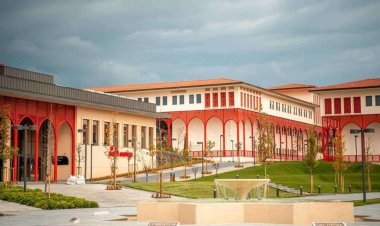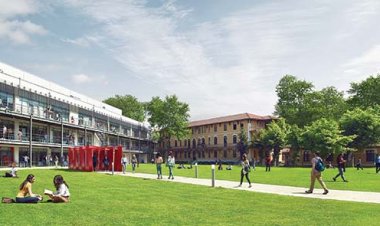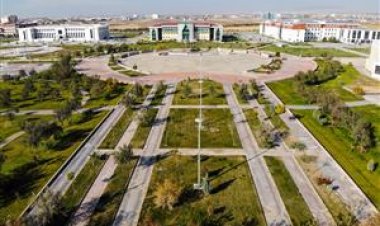Ravel’in müziğinin yapı taşları
Ravel’in müziğinin yapı taşları Yünter, Zeynep Maurice Ravel’in gerek piyano eserleri, gerek orkestra eserleri, müzik repertuvarında önemli bir yere sahiptir. Ravel’in müzik repertuvarına kazandırdıkları yalnızca eserleri ile sınırlı değildir; kendisi aynı zamana bir orkestrasyon dehası olmakla da bilinir. Ravel’in komposizyon tekniğindeki mekanik ustalık, Stravinsky’nin Ravel’e “İsviçre saati” atfı ile anlatılabilir. Buna rağmen Ravel’in kompozisyonundaki mekanik kusursuzluk kaygısı, müziğindeki renk kalitesinin önüne geçmez; soyut öğeleri net bir zemin üzerine oturtur. Tezin başlığı olan Ravel’in Müziğinin Yapı Taşları, bestecinin yaratısını doğrudan etkileyen görsel ve edebi akım ve şahsiyetler, dönemin politik ve sosyolojik gelişmeleri, Empresyonizm akımının müzikte öncüsü olarak kabul edilen Claude Debussy ile etkileşimi doğrultusunda geniş bir yelpazede değerlendirilerek oluşturulmuştur. Ravel’in kendine has müzikal stili zaman içerisinde, Fransız geleneklerine olan saygısı doğrultusunda, farklı kaynaklara olan ilgisinden de ötürü birçok unsuru içerisinde barındıran bir tutum ile şekillenir. Bu çalışmada Ravel hakkında yazılan kaynaklar ve eserler incelenerek, müziğini oluşturan ana unsurlar dört başlıkta ele alınmıştır. Birinci bölümde Maurice Ravel’in hayatı, ikinci bölümde komposizyon stilinin oluşmasındaki ana faktörler ve bestecinin kendisi ve müziği ile ilgili önemli kişilerin görüşleri, üçüncü bölümde orkestrasyonu, dördüncü bölümde ise sonuç ve önerilere yer verilmektedir. Both Maurice Ravel's piano and orchestration works are have a great importance in his musical oeuvre. He is not only known for the works that he contributed to the musical history, but also he is known as orchestration genius. Igor Stravinsky once referred to Ravel as "the most perfect of Swiss watchmakers" is a reference to Ravel's great mastership about the mechanical composition technique. However, Ravel's concern for mechanical perfection does not confront with the musical color quality that he provided in his works and he builds abstract elements on the top of the concrete ground. His own style evolved in many ways considering his respect to the French tradition and his interest to the different resources. The title of the thesis Elements of Ravel's Music, was named by evaluating a wide range of visual and literary movements and personalities that directly affected the composer's creation, political and sociological developments and his interaction with Claude Debussy who is acknowledged as the pioneer of the Impressionism movement in music also taken into considiration. In this study, by re-evaluating works and studies that written about him, components that formed his music discussed in four headlines. In the first part, Ravel's life presented, main factors that shaped his composition style and reflections about his music from others is discussed in second part, at the third part his orchestration analysed and forth part consist of conclusion and some suggestions.

Ravel’in müziğinin yapı taşları Yünter, Zeynep Maurice Ravel’in gerek piyano eserleri, gerek orkestra eserleri, müzik repertuvarında önemli bir yere sahiptir. Ravel’in müzik repertuvarına kazandırdıkları yalnızca eserleri ile sınırlı değildir; kendisi aynı zamana bir orkestrasyon dehası olmakla da bilinir. Ravel’in komposizyon tekniğindeki mekanik ustalık, Stravinsky’nin Ravel’e “İsviçre saati” atfı ile anlatılabilir.
Buna rağmen Ravel’in kompozisyonundaki mekanik kusursuzluk kaygısı, müziğindeki renk kalitesinin önüne geçmez; soyut öğeleri net bir zemin üzerine oturtur. Tezin başlığı olan Ravel’in Müziğinin Yapı Taşları, bestecinin yaratısını doğrudan etkileyen görsel ve edebi akım ve şahsiyetler, dönemin politik ve sosyolojik gelişmeleri, Empresyonizm akımının müzikte öncüsü olarak kabul edilen Claude Debussy ile etkileşimi doğrultusunda geniş bir yelpazede değerlendirilerek oluşturulmuştur. Ravel’in kendine has müzikal stili zaman içerisinde, Fransız geleneklerine olan saygısı doğrultusunda, farklı kaynaklara olan ilgisinden de ötürü birçok unsuru içerisinde barındıran bir tutum ile şekillenir.
Bu çalışmada Ravel hakkında yazılan kaynaklar ve eserler incelenerek, müziğini oluşturan ana unsurlar dört başlıkta ele alınmıştır. Birinci bölümde Maurice Ravel’in hayatı, ikinci bölümde komposizyon stilinin oluşmasındaki ana faktörler ve bestecinin kendisi ve müziği ile ilgili önemli kişilerin görüşleri, üçüncü bölümde orkestrasyonu, dördüncü bölümde ise sonuç ve önerilere yer verilmektedir.
Both Maurice Ravel's piano and orchestration works are have a great importance in his musical oeuvre. He is not only known for the works that he contributed to the musical history, but also he is known as orchestration genius. Igor Stravinsky once referred to Ravel as "the most perfect of Swiss watchmakers" is a reference to Ravel's great mastership about the mechanical composition technique. However, Ravel's concern for mechanical perfection does not confront with the musical color quality that he provided in his works and he builds abstract elements on the top of the concrete ground. His own style evolved in many ways considering his respect to the French tradition and his interest to the different resources. The title of the thesis Elements of Ravel's Music, was named by evaluating a wide range of visual and literary movements and personalities that directly affected the composer's creation, political and sociological developments and his interaction with Claude Debussy who is acknowledged as the pioneer of the Impressionism movement in music also taken into considiration. In this study, by re-evaluating works and studies that written about him, components that formed his music discussed in four headlines. In the first part, Ravel's life presented, main factors that shaped his composition style and reflections about his music from others is discussed in second part, at the third part his orchestration analysed and forth part consist of conclusion and some suggestions.

 Bilgi
Bilgi 















